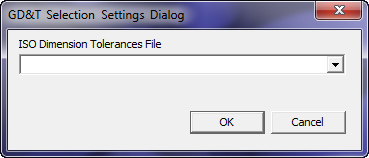
ISO tolerances have an alphanumeric label instead of normal plus and minus tolerance values. The labels appear as "H7", "h7", or "G9", for example, as shown below.

Example of ISO tolerances in a PC-DMIS graphic
The following is based on the ISO Standard 286-1, ISO system of limits and fits.
The letter ("H", "h", "g", etc.) indicates the tolerance class. It is case-sensitive: capital letters indicate holes or other internal shapes, while lower-case letters indicate stems or other external shapes.
The number indicates the grade of the tolerance.
For the ISO tolerances to work in PC-DMIS, the tolerance values must be set up in a CSV (comma-separated value) file.
The following two lines show a part of a sample CSV file and correspond to the first half of the '7' column in Table 6 of ISO 286-2: 1988 (E), which defines the values for an H7 tolerance:
H7, 0, 3, 6, 10, 18, 30, 50, 80, 120, 180, 250, 315, 400, 500 0.010, 0, 0.012, 0, 0.015, 0, 0.018, 0, 0.021, 0, 0.025, 0, 0.030, 0, 0.035, 0, 0.040, 0, 0.046, 0, 0.052, 0, 0.057, 0, 0.063, 0
The initial entry on the first line, H7, defines the type of tolerance these two lines apply to. The values in these two lines are only applied to tolerances that have H7 in them.
The rest of that line defines the size categories. The first size category is for dimensions greater than 0 and less than or equal to 3. The second category is for dimensions greater than 3 and less than or equal to 6. The third category is for dimensions larger than 6 and less than or equal to 10, etc.
The next line gives the tolerance values that match up to the size categories in line 1. The plus and minus tolerances for the first size category is +0.010/-0. The second is +0.012/-0. The third is +0.015/-0, etc.
To import a tolerance CSV file:
Select Edit | Preferences | CAD GD&T Selection to show the GD&T Selection Settings Dialog dialog box.
From the GD&T Selection Settings Dialog dialog box, use the ISO Dimensions Tolerance File combination box to choose the CSV file:

GD&T Selection Settings Dialog dialog box
Click OK to import the CSV file.
For more detailed information on ISO dimension and tolerance standards, visit the ISO website.